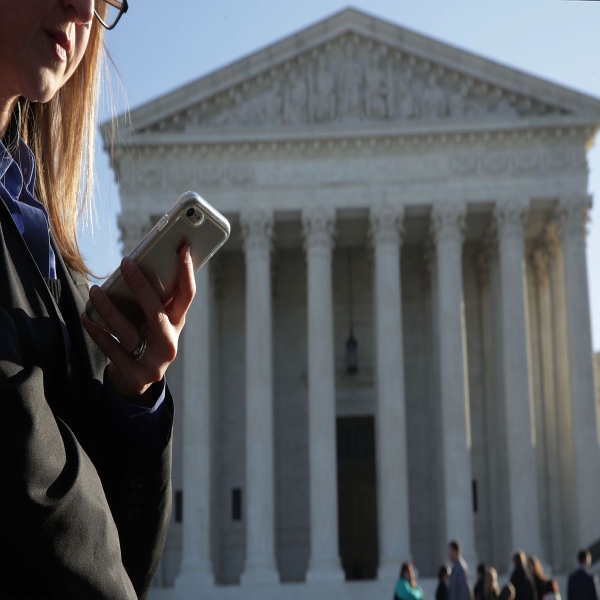A rogue federal court effectively put the Republican Party in charge of social media, and now the justices have to deal with this mess.

Ian Millhiser is a senior correspondent at Vox, where he focuses on the Supreme Court, the Constitution, and the decline of liberal democracy in the United States. He received a JD from Duke University and is the author of two books on the Supreme Court.
About a year ago, an especially right-wing panel of the far-right United States Court of Appeals for the Fifth Circuit held that Texas’s state government may effectively seize control of content moderation on social media websites such as Twitter, YouTube, and Facebook.
The Fifth Circuit’s opinion in NetChoice v. Paxton upheld an unconstitutional law that requires social media companies to publish content produced by their users that they do not wish to publish, but that the government of Texas insists that they must publish. That potentially includes content by Nazis, Ku Klux Klansmen, and other individuals calling for the outright extermination of minority groups.
The Supreme Court announced on September 29 that it would hear the NetChoice case, along with a case challenging a very similar Florida law. The Court will most likely release opinions in both cases by the end of June.
Meanwhile, earlier this month the same Fifth Circuit handed down a decision that effectively prohibits the Biden administration from asking social media companies to pull down or otherwise moderate content. According to the Justice Department, the federal government often asks these platforms to remove content that seeks to recruit terrorists, that was produced by America’s foreign adversaries, or that spreads disinformation that could harm public health.
Again, the Fifth Circuit’s more recent decision, which is known as Murthy v. Missouri, would devastate a Democratic administration’s ability to ask media companies to voluntarily remove content. Meanwhile, the NetChoice decision holds that Texas’s Republican government may compel those same companies to adopt a government-mandated editorial policy.
These two decisions obviously cannot be reconciled, unless you believe that the First Amendment applies differently to Democrats and Republicans. And the Supreme Court has already signaled, albeit in a 5-4 decision, that a majority of the justices believe that the Fifth Circuit has gone off the rails. Soon after the Fifth Circuit first signaled that it would uphold Texas’s law, the Supreme Court stepped in with a brief order temporarily putting the law on ice.
Yet, while the Fifth Circuit’s approach to social media has been partisan and hackish, these cases raise genuinely difficult policy questions. Social media companies control powerful platforms that potentially allow virtually anyone to communicate their views to millions of people at a time. These same companies also have the power to exclude anyone they want from these platforms either for good reasons (because someone is a recruiter for the terrorist group ISIS, for example), or for arbitrary or malicious reasons (such as if the company’s CEO disagrees with an individual’s ordinary political views).
Worse, once a social media platform develops a broad user base, it is often difficult for other companies to build competing social networks. After Twitter, now known as X, implemented a number of unpopular new policies that favored trolls and hate speech, for example, at least eight other platforms tried to muscle into this space with Twitter-like apps of their own. Thus far, however, these new platforms have struggled to consolidate the kind of user base that can rival Twitter’s. And the one that most likely presents the greatest threat to Twitter, Threads, is owned by social media giant Meta.
It is entirely reasonable, in other words, for consumers to be uncomfortable with so few corporations wielding so much authority over public discourse. What is less clear is what role the government legitimately can play in dealing with this concentration of power.
What the First Amendment actually says about the government’s relationship with media companies
Before we dive into the details of the NetChoice and Murthy decisions, it’s helpful to understand a few basics about First Amendment doctrine, and just how much pressure the government may place on a private media company before that pressure crosses the line into illegal coercion.
First, the First Amendment protects against both government actions that censor speech and government actions that attempt to compel someone to speak against their will. As the Supreme Court explained in Rumsfeld v. Forum for Academic and Institutional Rights (2006), “freedom of speech prohibits the government from telling people what they must say.”
Second, the First Amendment also protects speech by corporations. This principle became controversial after the Supreme Court’s decision in Citizens United v. FEC (2010) held that corporations may spend unlimited sums of money to influence elections, but it also long predates Citizens United. Indeed, a world without First Amendment protections for corporations is incompatible with freedom of the press. Vox Media, the New York Times, the Washington Post, and numerous other media companies are all corporations. That doesn’t mean that the government can tell them what to print.
Third, the First Amendment specifically protects the right of traditional media companies to decide what content they carry and what content they reject. Thus, in Miami Herald v. Tornillo (1974), the Supreme Court held that a news outlet’s “choice of material to go into a newspaper” is subject only to the paper’s “editorial control and judgment,” and that “it has yet to be demonstrated how governmental regulation of this crucial process can be exercised consistent with First Amendment guarantees of a free press.”
Fourth, this regime applies equally to internet-based media. The Supreme Court’s decision in Reno v. ACLU (1997) acknowledged that the internet is distinct from other mediums because it “can hardly be considered a ‘scarce’ expressive commodity” — that is, unlike a newspaper, there is no physical limit on how much content can be published on a website. But Reno concluded that “our cases provide no basis for qualifying the level of First Amendment scrutiny that should be applied to this medium.”
Taken together, these four principles establish that neither Texas nor any other governmental body may require a media company, social or otherwise, to publish content that the company does not want to print. If Twitter announces tomorrow that it will delete all tweets written by someone named “Jake,” for example, the government may not pass a law requiring Twitter to publish tweets by Jake Tapper. Similarly, if a social media company announces that it will only publish content by Democrats, and not by Republicans, it may do so without government interference.
That said, while the government may neither censor a media platform’s speech nor demand that the platform publish speakers it does not want to publish, government officials are allowed to express the government’s view on any topic. Indeed, as the Supreme Court said in Pleasant Grove v. Summum (2009), “it is not easy to imagine how government could function if it lacked this freedom.”
The government’s freedom to express its own views extends both to statements made to the general public and to statements made in private communications with business leaders. Federal officials may, for example, tell YouTube that the United States government believes that the company should pull down every ISIS recruitment video on the site. And those officials may also ask a social media company to pull down other content that the government deems to be harmful, dangerous, or even merely annoying.
Of course, the general principle that the government can say what it wants can sometimes be in tension with the rule against censorship. While the First Amendment allows, say, Florida Gov. Ron DeSantis (R) to make a hypothetical statement saying that he opposes all books that present transgender people in a positive light, DeSantis would cross an impermissible line if he sends a police officer to a bookstore to make a thinly veiled threat — such as if the cop told the storeowner that “bad things happen to people who sell these kinds of books.”
But a government statement to a private business must be pretty egregious before it crosses the line into impermissible censorship. As the Court held in Blum v. Yaretsky (1982), the government may be held responsible for a private media company’s decision to alter its speech only when the government “has exercised coercive power or has provided such significant encouragement, either overt or covert, that the choice must in law be deemed to be that of the State.”
So how should these First Amendment principles apply to government-mandated content moderation?
In fairness, none of the Supreme Court decisions discussed in the previous section involve social media companies. So it’s at least possible that these longstanding First Amendment principles need to be tweaked to deal with a world where, say, a single billionaire can buy up a single website and fundamentally alter public discourse among important political and media figures.
But there are two powerful reasons to tread carefully before remaking the First Amendment to deal with The Problem of Elon Musk.
One is that no matter how powerful Musk or Mark Zuckerberg or any other media executive may become, they will always be categorically different from the government. If Facebook doesn’t like what you have to say, it can kick you off Facebook. But if the government doesn’t like what you say (and if there are no constitutional safeguards against government overreach), it can send armed police officers to haul you off to prison forever.
The other is that the actual law that Texas passed to deal with the Texas GOP’s concerns about social media companies is so poorly designed that it suggests that a world where the government can regulate social media speech would be much worse than one where important content moderation decisions are made by Musk.
That law, which Texas Gov. Greg Abbott (R) claims was enacted to stop a “dangerous movement by social media companies to silence conservative viewpoints and ideas,” prohibits the major social media companies from moderating content based on “the viewpoint of the user or another person” or on “the viewpoint represented in the user’s expression or another person’s expression.”
Such a sweeping ban on viewpoint discrimination is incompatible with any meaningful moderation of abusive content. Suppose, for example, that a literal Nazi posts videos on YouTube calling for the systematic extermination of all Jewish people. Texas’s law prohibits YouTube from banning this user or from pulling down his Nazi videos, unless it also takes the same action against users who express the opposite viewpoint — that is, the view that Jews should not be exterminated.
In any event, the Supreme Court already blocked the Texas law once, so it’s unlikely that it will reverse course when it hears the case a second time.
What should happen when the government merely asks a social media company to remove content?
But what about a case like Murthy? That case is currently before the Supreme Court on its shadow docket — a mix of emergency motions and other matters that the Court sometimes decides on an expedited basis — so the Court could decide any day now whether to leave the Fifth Circuit’s decision censoring the Biden administration in effect.
The Fifth Circuit’s Murthy decision spends about 14 pages describing cases where various federal officials, including some in the Biden White House, asked social media companies to remove content — often because federal officials thought the content was harmful to public health because it contained misinformation about Covid-19.
In many cases, these conversations happened because those companies proactively reached out to the government to solicit its views. As the Fifth Circuit admits, for example, platforms often “sought answers” from the Centers for Disease Control and Prevention about “whether certain controversial claims were ‘true or false’” in order to inform their own independent decisions about whether or not to remove those claims.
That said, the Fifth Circuit also lists some examples where government officials appear to have initiated a particular conversation. In one instance, for example, a White House official allegedly told an unidentified platform that it “remain[ed] concerned” that some of the content on the platform encouraged vaccine hesitancy. In another instance, Surgeon General Vivek Murthy allegedly “asked the platforms to take part in an ‘all-of-society’ approach to COVID by implementing stronger misinformation ‘monitoring’ program.”
It’s difficult to assess the wisdom of these communications between the government and the platforms because the Fifth Circuit offers few details about what content was being discussed or why the government thought this content was sufficiently harmful that the platforms should intervene. Significantly, however, the Fifth Circuit does not identify a single example — not one — of a government official taking coercive action against a platform or threatening such action.
The court does attempt to spin a couple of examples where the White House endorsed policy changes as such a threat. In a 2022 news conference, for example, the White House press secretary said that President Biden supports reforms that would impact the social media industry — including “reforms to section 230, enacting antitrust reforms, requiring more transparency, and more.” But the president does not have the authority to enact legislative reforms without congressional approval. And the platforms themselves did not behave as if they faced any kind of threat.
Indeed, the Fifth Circuit’s own data suggests that the platforms felt perfectly free to deny the government’s requests, even when those requests came from law enforcement. The FBI often reached out to social media platforms to flag content by “Russian troll farms” and other malign foreign actors. But, as the Fifth Circuit concedes, the platforms rejected the FBI’s requests to pull down this content about half of the time.
And, regardless of how one should feel about the government communicating with media sites about whether Russian and anti-vax disinformation should remain online, the Fifth Circuit’s approach to these communications is ham-handed and unworkable.
At several points in its opinion, for example, the Fifth Circuit faults government officials who “entangled themselves in the platforms’ decision-making processes.” But the court never defines this term “entangled,” or even provides any meaningful hints about what it might mean, other than using equally vague adjectives to describe the administration’s communications with the platforms, such as “consistent and consequential.”
The Biden administration, in other words, appears to have been ordered not to have “consistent and consequential” communications with social media companies — whatever the hell that means. Normally, when courts hand down injunctions binding the government, they define the scope of that injunction clearly enough that it’s actually possible to figure out what the government is and is not allowed to do.
The common element in NetChoice and Murthy is that, in both cases, government officials (the Texas legislature in NetChoice and three Fifth Circuit judges in Murthy) were concerned about certain views being suppressed on social media. And, in both cases, they came up with a solution that is so poorly thought out that it is worse than whatever perceived problem they were trying to solve.
Thanks to the Fifth Circuit, for example, the FBI has no idea what it is allowed to do if it discovers that Vladimir Putin is flooding Facebook, YouTube, and Twitter with content that is actively trying to incite an insurrection within the United States. And, thanks to the Fifth Circuit, there’s now one First Amendment that Democrats must comply with, and a different, weaker First Amendment that applies to Republican officials.
We can only hope that the Supreme Court decides to step back and hit pause on this debate, at least until someone can come up with a sensible and workable framework that can address whatever problems the Texas legislature and the Fifth Circuit thought they were solving.
Update, September 29, 10:15 am: This story, originally published September 22, has been updated with news that the Supreme Court took two of the relevant cases.
Source: vox.com






